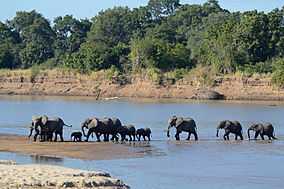South Luangwa National Park
| South Luangwa National Park | |
|---|---|
|
IUCN category II (national park) | |
|
Elephants crossing the Luangwa River | |
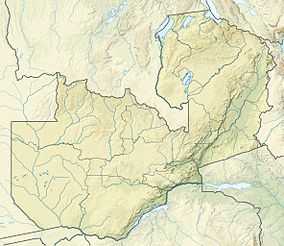 | |
| Location | Zambia |
| Nearest city | Mfuwe, Zambia |
| Coordinates | 13°0′S 31°30′E / 13.000°S 31.500°ECoordinates: 13°0′S 31°30′E / 13.000°S 31.500°E |
| Area | 9,050 km² |
| Established | 1972 |
South Luangwa National Park in eastern Zambia, the southernmost of three national parks in the valley of the Luangwa River, is a world-renowned wildlife haven. It supports large populations of Thornicroft's Giraffe, and herds of elephant and buffalo often several hundred strong, while the Luangwa River supports abundant crocodiles and hippopotamuses. It is one of the best-known national parks in Africa for walking safaris. Founded as a game reserve in 1938, it became a national park in 1972 and now covers 9,050 km².
The Muchinga Escarpment in Northern and Central Provinces forms the park's western or north-western boundary, it slopes down from there to the river, lying mostly on its western bank. The eastern bank of the river is in Eastern Province, and as access to the park is only from that side, it is usually thought of as being wholly in Eastern Province.
Background
The park spans two ecoregions, both of them woodland savannah, distinguished by the dominant tree: Southern Miombo woodlands cover the higher slopes of the valley, while Zambezian and Mopane woodlands cover the bottom of the valley. The Mopane tree tolerates the higher temperatures and lower rainfall found at lower elevations than Miombo trees which are found on the higher plateau. Within these woodland savannahs are larger patches of grassland, so that grazers such as zebra and leaf browsers such as giraffe are found in profusion in the same areas. Patches of flooded grassland habitats (floodplains) are found close to the river, on which hippopotamus graze at night. Their dung released into the river fertilises its waters and sustains the fish population which in turn sustains the crocodiles.
The Luangwa valley, continued to the west by the Lunsemfwa River valley, contains some varieties of animals such as Cookson's wildebeest and Crawshay's zebra which are endemic or near-endemic to the valley. It also represents something of a natural barrier to human migration and transport, no roads cross it and this has helped conserve its wildlife.
Although the park is generally well-protected from poaching, the park's black rhinos were wiped out by 1987, and the elephant population has been under serious pressure at times.
The main settlement of the park is actually outside its eastern boundary at Mfuwe, home to an international airport.
Gallery
-

Mopane woodland in Game Management Area adjoining the NP
-
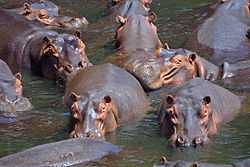
Pod of hippopotamuses in the park.
-

A Wild Buffalo at Mfuwe
-
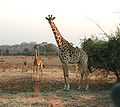
Thornicroft's Giraffes in South Luangwa
-
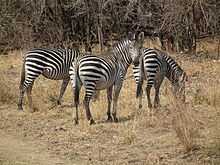
Crawshay's Zebra in South Luangwa National Park
-

Lion & Lioness at South Luangwa National Park
See also
References
External links
| Wikimedia Commons has media related to South Luangwa National Park. |
![]() South Luangwa National Park travel guide from Wikivoyage
South Luangwa National Park travel guide from Wikivoyage
